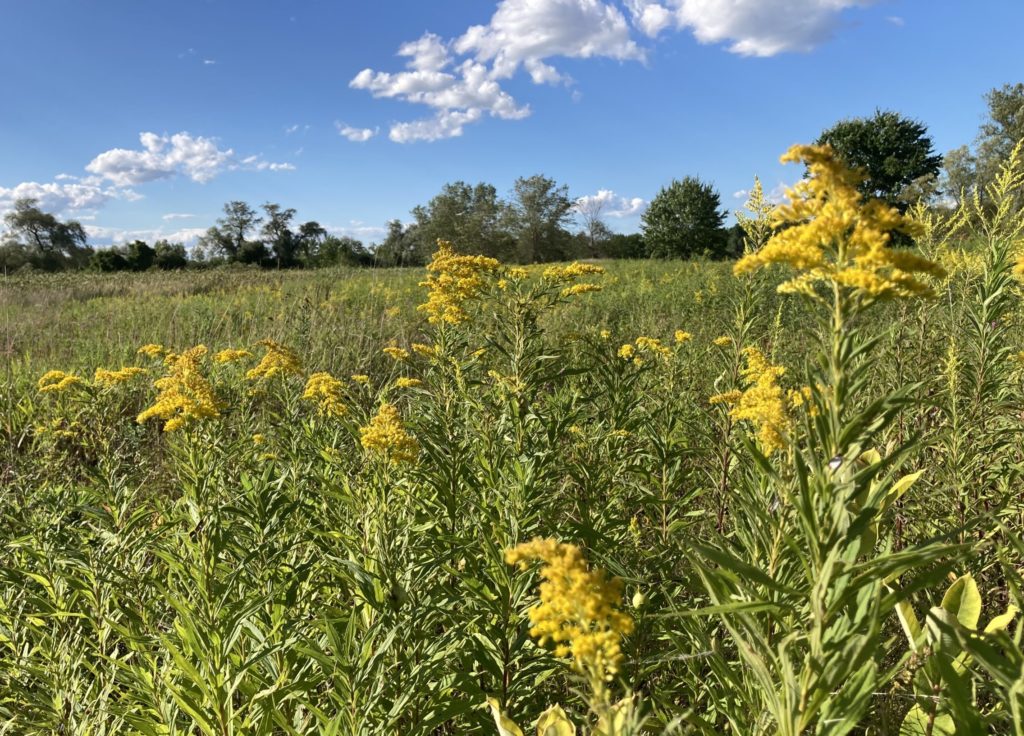Almanac: Golden Herald

These are probably Canada goldenrod (Solidago canadensis) but, honestly, there are so many similar-looking goldenrod species that it’s safer just to say “goldenrod.” Photo: Stephen Braun
It was more than a month ago that I saw goldenrod blooming for the first time this year. It was surprising–and briefly depressing–since goldenrod is so closely associated with fall in my mind. But until just this week, the heat and drought of August made fall seem like a fantasy, no matter what the goldenrod was saying.
Those specimens of early-flowering goldenrod are now fading, replaced by the bulk of the more than 25 species of goldenrod growing in Massachusetts. These plants have a propensity to hybridize, which can make field identification of all but the most unique species challenging. As the caption above explains, I’m pretty sure those were Canada goldenrod flower heads I caught nodding in a breeze the other day, but I wouldn’t put money on it. The only goldenrod I’d be certain about identifying is the one regional member of the Solidago family that is not actually golden: Solidago bicolor, called silverrod because it produces tall clusters of white flowers.
Goldenrod is a terrific native plant supporting dozens of kinds of pollinating insects in the fall and some songbirds in the winter. But this beautiful herald of fall frequently gets a bad rap because some people think it’s the source of their hay fever misery. Goldenrod, however, is innocent. Its eye-popping color is testimony to that. Goldenrod is yellow to attract bees, wasps, and other insects it needs to help pollination. Goldenrod pollen grains are heavy and sticky and not easily carried by the wind into the quivering nostrils of hay fever sufferers. The real culprits are ragweeds and mugworts, whose flowers are dull-colored and inconspicuous because they rely on the wind, not insects, to distribute all those billions of pollen grains that keep the antihistamine industry thriving.
If you’re out and about admiring fields of goldenrod, you’re likely to notice that some goldenrod stems look like they swallowed a large marble. These spherical swellings are a response to the larvae of goldenrod gall flies. The female flies inject their eggs into goldenrod stems in mid-summer. As the larvae grow and eat, a chemical in their saliva hijacks the genetic machinery of the plant’s cells causing a cancer-like, above-normal cell division that forms the ball-like larval home we call a gall.
Where I hail from—upstate New York—it is common to see abandoned fields packed with the intense gold/yellows of goldenrods contrasting with deep purple bouquets of New England asters. Here, in actual New England, I don’t find this delightful combination nearly so often, although the other day I did see a lone New England aster flowering in the fields west of UMass, near the goldenrods.

Robin Wall Kimmerer, in her wonderful book Braiding Sweetgrass, writes movingly about her love of the goldenrod/New England aster combination. When she was asked why she wanted to major in botany during her freshman intake interview at the forestry school she attended, she said she wanted to learn why asters and goldenrod looked so beautiful together. The faculty adviser was not impressed. “If you want to study beauty, you should go to art school,” he tartly replied.
Kimmerer persisted—thank goodness—and is now both a professor of botany and one of the foremost experts on the botanical wisdom and knowledge of indigenous peoples. She has explored scientific explanations for the appeal of the gold/purple combination of goldenrods and asters, but she also takes a wider and deeper view:
“Why are they beautiful together? It is a phenomenon simultaneously material and spiritual, for which we need all wavelengths of knowledge. When I stare too long at the world with science eyes, I see an afterimage of indigenous knowledge. Might science and traditional knowledge be purple and yellow to one another? We see the world more fully when we use both.”
Almanac is a regular Indy column of observations, musings, and occasional harangues related to the woods, waters, mountains, and skies of the Pioneer Valley. Please feel free to comment on posts and add your own experiences or observations.

S,
I love the evolutionary logic you employ to acquit these innocent flowers!
R
I am fortunate to have inherited two magnificent stands of goldenrod in my yard, and am eagerly looking to add more. The bees are delighted with its presence. I also have an explosion of asters — not the deep purple variety, but the more subtle lighter blue — there are stands of milkweed in both my yard and my neighbor’s, and I’ll be adding thistle to the mix next year. My yard is small — I like to call it the back 40 feet — but there is plenty of room for coexistence of practical vegetable types and wild inhabitants.